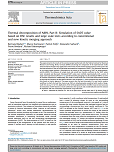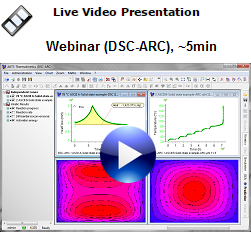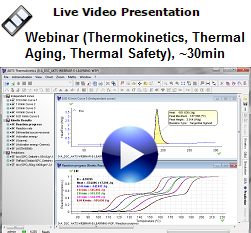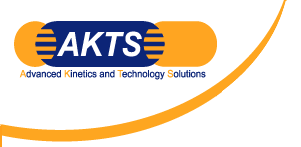|
The thermal behaviour of the reactive chemicals can be evaluated from DSC experiments (mg scale) or other specific methods (g- and kg- scale) such as cookoff, Dewar Calorimetry, large scale experiments as those applied during SADT evaluation (up to 50kg) carried out according to UN Regulations, or measurements done by means of Accelerating Rate Calorimetry (ARC). The main difference between DSC and other above mentioned techniques is the fact that only in DSC scans all heat evolved during exothermic reaction is fully exchanged with an environment. In other methods part of the heat evolved during reaction (or almost all as during adiabatic experiments) stays in the sample leading to its temperature rise. This, in turn, leads to uncontrolled temperature gradient in the sample which is negligible in DSC experiments, however may be significant and has to be considered in other experimental techniques. The proper heat balance in the system i.e. the exact comparison of the rates of heat formation and its loss plays an important role during data evaluation and simulations of any real-scale experiments.
Recently AKTS has participated in project performed with the Federal Institute for Materials Research and Testing, Berlin, Germany (BAM). The results of this project in which the Self Accelerating Decomposition Temperature (SADT) of AIBN was investigated clearly show that experiments carried out in mg scale and the application of the kinetic-based method and heat balance of the system can be used for the evaluation properties of the materials in g- and kg-scale.
The AKTS contribution to the project has been published in Thermochimica Acta. The paper is in print, however already available in open access at the following link:
http://dx.doi.org/10.1016/j.tca.2015.06.014

The highlights of this paper are the following:
- Kinetic-based simulations were applied for evaluation of SADT for AIBN
- Correct kinetic approach and appropriate heat balance allowed successful scale up
- Simulated SADT values were verified experimentally by large-scale experiments (5, 20 and 50 kg)
- Influence of sample mass and overall heat transfer coefficient U on SADT was evaluated
- New kinetic approach based on merging DSC and large scale data was proposed.
In the above project AKTS has applied two strategies:
- Conventional kinetic approach in which the kinetic parameters of the decomposition reaction evaluated in mg scale by DSC are used together with the heat balance for the simulation of the thermal behavior of the sample
- Merging approach in which for the prediction of SADT the result of large scale experiments is linked with the single DSC run.
In present newsletter we illustrate the further stage of the merging approach: the benefits of merging ARC data obtained e.g. in Heat-Wait-Search (HWS) mode with single DSC experiment. Such a novel approach includes several important advantages. The newly proposed merging approach, based on utilisation of the results from different experimental techniques, omits the limitations of particular experimental methods: (i) those of DSC in which the heat loss rate from the system is not measured and this important parameter is obtained by numerical heat balance only, and (ii) those of ARC or large scale tests which do not allow the precise evaluation of the second important parameter: the kinetics of the heat formation in the system. Since the limitations of these techniques are generally exclusive it seems to be advantageous to use their combination. In merging approach one can apply the results of single DSC experiment only and ARC data or the results of one large scale experiment such H.1, Dewar or slow cookoff. The application of a newly proposed kinetic workflow may increase accuracy of simulations of SADT based on results collected in mg-scale and decrease the amount of ARC tests or expensive and time consuming experiments in kg-scale.
Details and explanation of the novel merging kinetic approach is given in Application Notes.
Application notes:
New kinetic approach for evaluation of Thermal Hazard Indicators based on DSC and large scale tests (DSC & ARC, DSC & UN Test H.1, DSC & Dewar, DSC & Cookoff data, etc.)
The following Webinar and notes present the work-flow of kinetic analysis based on DSC and ARC traces (ARC can be replaced by other technique as well (e.g. UN Test H.1, Dewar or Cookoff data)). The procedure requires performing single DSC experiment measured at e.g. 0.5 K/min or 1 K/min (or under isothermal conditions) and one ARC run performed e.g. in HWS mode. After finishing optimization procedure of both experimental traces one can evaluate the safety indicators such as TMRad (Time to Maximum Rate under adiabatic conditions), SADT, etc. In these calculations the optimized parameters evaluated simultaneously from two independent techniques (DSC & ARC) are applied.

Please see also the general webinar based on kinetic analysis of DSC data.

For more information about AKTS-Thermokinetics Software:
1- AKTS-Thermokinetics Software ‘Thermal Aging’ Version
(for kinetic analysis and shelflife predictions of materials)
http://www.akts.com/thermal-aging-in-situ-overview.html
http://www.akts.com/thermal-aging-ex-situ-overview.html
2- AKTS-Thermokinetics Software ‘Thermal Aging’ & ‘Thermal Safety’ Versions
(for kinetic analysis, shelflife predictions and thermal hazard analysis of decomposition reactions (Time to Maximum Rate under adiabatic conditions (TMRad), Self-Accelerating Decomposition Temperature (SADT), etc.)
http://www.akts.com/thermal-safety-overview.html
3- AKTS-Thermokinetics Software ‘Reaction Calorimetry’ Versions
(for kinetic analysis and process optimization of synthesis reactions in Batch, Semi-Batch, Continuous Stirred Tank, Reactor, Plug-Flow and Cascade of reactors).
http://www.akts.com/reaction-calorimetry-overview.html
Yours sincerely,
AKTS AG
AKTS AG
Advanced Kinetics
& Technology Solutions
TECHNOArk 1
3960 Siders
Switzerland |
If you do not wish to receive emails from AKTS AG, please click here. |

